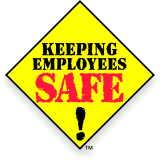Home » Lockout Resources » OSHA Documentation » Interactive Case Studies » Steel Mill Teeming Car Repairs
Steel Mill Teeming Car Repairs
Case Study
An employee is assigned to adjust part of the drive mechanism on a teeming car in a steel mill. The teeming car is Isolated from its energy sources and locked out, and the employee crawls underneath the car to start the Maintenance job.
The employee, however, fails to shut down or deenergize a separate motor-driven unit used to position the teeming cars. While the employee is performing the Maintenance, the motor-driven unit is activated for production purposes and rolls by on adjacent tracks, causing injury to the employee.
Question 1
Is the employer required to shut down and lock out related machinery operating in the area of the covered service and Maintenance, if that machinery could cause injury?
- Yes
-

Correct.
The employer is obligated to provide the Servicing and Maintenance employee with protection against Hazardous Energy from interconnected and nearby machines or equipment which could cause injury. In this case, the energy control procedures were implemented for the teeming car. The employer failed, however, to lock out interconnected and nearby machines or equipment which exposed the maintenance worker to hazardous energy.
The employer could either provide effective machine guarding or ensure that the Energy Control Procedure for the teeming car requires the Authorized Employee to implement the energy control procedures for the motor-driven unit and for other interconnected or nearby equipment or machines. If the employer were to install guarding, it must protect the authorized employee from the Hazardous Energy of the interconnected or nearby machinery. If the guarding does not adequately protect the authorized employee during this Servicing and Maintenance activity, the interconnected and nearby machines or equipment must be deenergized and locked out/tagged out. In this case study, because guarding had not been installed, the employer was obligated to implement energy control procedures for the interconnected or nearby machines. The employer therefore failed to implement procedures to shut down, isolate, block, and secure machines or equipment to control hazardous energy (described in 29 CFR 1910.147(c)(4)(ii)(B)).
NOTE: This analysis could be readily applied to a scenario where Maintenance must be performed on a punch press in an area crowded with other presses or Energized equipment.
- No
-

Incorrect. In this scenario, this step must be taken.
The employer is obligated to provide the Servicing and Maintenance employee with protection against Hazardous Energy from interconnected and nearby machines or equipment which could cause injury. In this case, the energy control procedures were implemented for the teeming car. The employer failed, however, to lock out interconnected and nearby machines or equipment which exposed the maintenance worker to hazardous energy.
The employer could either provide effective machine guarding or ensure that the Energy Control Procedure for the teeming car requires the Authorized Employee to implement the energy control procedures for the motor-driven unit and for other interconnected or nearby equipment or machines. If the employer were to install guarding, it must protect the authorized employee from the Hazardous Energy of the interconnected or nearby machinery. If the guarding does not adequately protect the authorized employee during this Servicing and Maintenance activity, the interconnected and nearby machines or equipment must be deenergized and locked out/tagged out. In this case study, because guarding had not been installed, the employer was obligated to implement energy control procedures for the interconnected or nearby machines. The employer therefore failed to implement procedures to shut down, isolate, block, and secure machines or equipment to control hazardous energy (described in 29 CFR 1910.147(c)(4)(ii)(B)).
NOTE: This analysis could be readily applied to a scenario where Maintenance must be performed on a punch press in an area crowded with other presses or Energized equipment.
Source: www.osha.gov
Lockout Services | Turnkey Programs | Lockout Procedures | Single-Source Procedures | Basic Procedures | Standard Procedures | Advanced Procedures | Custom Procedures | Energy Control Tags | Alternative Protective Measures | Minor Servicing Exception | Online Services | Lockout Audits | Corporate Standards | Lockout Training | Reference Guides | Services RFQ | DEenergizer | Lockout Devices | Electrical | Valve and Pneumatic | Accessories | Group Lockout/Tagout | Devices Index | Devices RFQ | Lockout Resources | OSHA Documentation | NIOSH Documentation | White Papers and Articles | Lockout/Tagout FAQ | Lockout/Tagout News | Lockout/Tagout Signs | Energy Source Reference | Training Material | Library | Glossary | Sitemap | About | Contact Information | Careers | Privacy Policy | Terms of Use | Legal Notice

